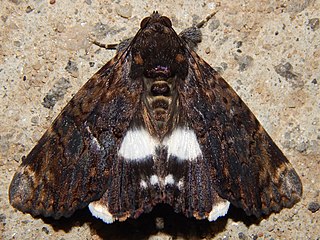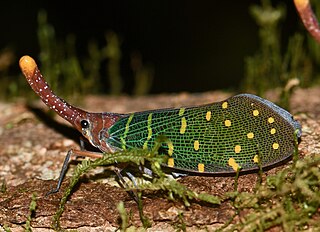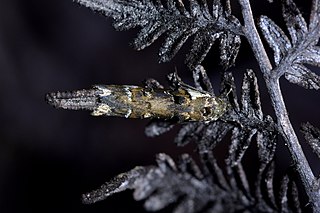
Acraea terpsicore, the tawny coster, is a small, 53–64 millimetres (2.1–2.5 in), leathery-winged butterfly common in grassland and scrub habitats. It belongs to the Nymphalidae or brush-footed butterfly family. It has a weak fluttery flight. It is avoided by most insect predators. This species and the yellow coster are the only two Indian representatives of the predominantly African tribe Acraeini. It is found in India, Sri Lanka, Maldives to Myanmar, Thailand, Laos, Cambodia, Vietnam, Bangladesh, Singapore, and recently Australia

Symphaedra nais, also known as the baronet, is a species of Nymphalid butterfly found in South Asia. It was formerly included in the genus Euthalia but it is a sister to members of the genus Bassarona.

Odontoptilum angulata, the chestnut angle or banded angle, is a butterfly belonging to the family Hesperiidae and is found in India and southeast Asia.

Hypolimnas misippus, the Danaid eggfly, mimic, or diadem, is a widespread species of nymphalid butterfly. It is well known for polymorphism and mimicry. Males are blackish with distinctive white spots that are fringed in blue. Females are in multiple forms that include male-like forms while others closely resemble the toxic butterflies Danaus chrysippus and Danaus plexippus.

The Morris–Butler House is a Second Empire-style house built about 1864 in the Old Northside Historic District of Indianapolis, Indiana. Restored as a museum home by Indiana Landmarks between 1964 and 1969, the American Civil War-era residence was the non-profit organization's first preservation project. Restoration work retained some of its original architectural features, and the home was furnished in Victorian and Post-Victorian styles. Its use was changed to a venue for Indiana Landmarks programs, special events, and private rentals following a refurbishment in 2013. Regular daily tours of the property have been discontinued.

Catephia is a genus of moths of the family Erebidae. Most species of this genus are found in Africa.

Dindica olivacea is a moth of the family Geometridae first described by Hiroshi Inoue in 1990. It is found in the north-eastern Himalayas, south-eastern Asia, as well as on Borneo, Sumatra and the Philippines. The habitat consists of lowland forests.

Nagia linteola is a species of moth in the family Erebidae first described by Achille Guenée in 1852. This species occurs in South Africa, the Democratic Republic of the Congo, Yemen, the Comoros, Mauritius, Madagascar, Indonesia (Borneo), India, Sri Lanka, Myanmar, Thailand and in Australia, where it has been recorded from Western Australia, the Northern Territory, Queensland and Victoria.
Catephia diphteroides is a species of moth of the family Erebidae. It is found in Sri Lanka.
Catephia eurymelas is a species of moth of the family Erebidae. It is found in Kenya.
Catephia flavescens is a species of moth of the family Erebidae. It is found in India (Sikkim).
Catephia pyramidalis is a species of moth of the family Erebidae. It is found in Kenya.
Catephia poliochroa is a species of moth of the family Erebidae. It is found in Kenya.
Catephia pericyma is a species of moth of the family Erebidae. It is found in Egypt, Kenya, Oman, Saudi Arabia, the United Arab Emirates and Yemen.
Catephia mesonephele is a species of moth of the family Erebidae. It is found in Eritrea, Ethiopia and Kenya.
Erygia plagifera is a moth of the family Erebidae. It is found in Singapore.
Compsolechia binotatella is a moth of the family Gelechiidae. It was described by Francis Walker in 1864. It is found in Amazonas, Brazil.

Pyrops intricatus is a species of lantern bug, an insect in the family Fulgoridae, found in Borneo. It was originally described in 1857 by Francis Walker as Hotinus intricatus.

Trachypepla conspicuella is a species of moth in the family Oecophoridae. It is endemic to New Zealand and is found in both the North and South Islands. It is similar in appearance to its close relative T. euryleucota but tends to be paler. Its colouration imitates bird droppings. Larvae feed on leaf litter. Adults of this species are on the wing from November to February and have been observed resting on fences and walls.









